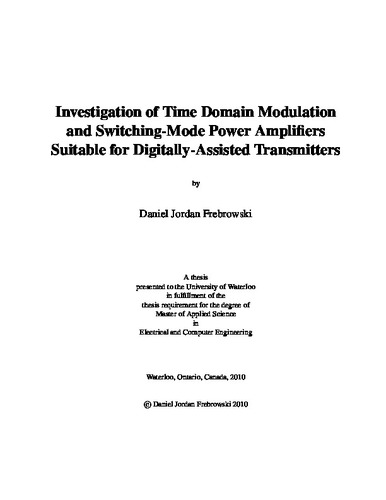| dc.contributor.author | Frebrowski, Daniel Jordan | |
| dc.date.accessioned | 2010-09-22 13:58:16 (GMT) | |
| dc.date.available | 2010-09-22 13:58:16 (GMT) | |
| dc.date.issued | 2010-09-22T13:58:16Z | |
| dc.date.submitted | 2010 | |
| dc.identifier.uri | http://hdl.handle.net/10012/5492 | |
| dc.description.abstract | Innovation in wireless communication has resulted in accelerating demand for smartphones using multiple communications protocols such as WiFi, Bluetooth and the many cellular standards deployed around the world. The variety of frequency, bandwidth and power requirements associated with each standard typically calls for the implementation of separate radio frequency (RF) front end hardware for each standard. This is a less-than-ideal solution in terms of cost and device area. Software-defined radio (SDR) promises to solve this problem by allowing the RF hardware to be digitally reconfigurable to adapt to any wireless standard. The application of machine learning and cognition algorithms to SDR will enable cognitive radios and cognitive wireless networks, which will be able to intelligently adapt to user needs and surrounding radio spectrum conditions.
The challenge of fully reconfigurable transceivers is in implementing digitally-controlled RF circuits which have comparable performance to their fixed-frequency counterparts. Switching-mode power amplifiers (SMPA) are likely to be an important part of fully reconfigurable transmitters since their switching operation provides inherent compatibility with digital circuits, with the added benefit of very high efficiency. As a step to understanding the RF requirements of high efficiency and switching PAs, an inverse class F PA in push-pull configuration is implemented. This configuration is chosen for its similarity to the current mode class D (CMCD) topology. The fabricated PA achieves a peak drain efficiency of over 75% with 42.7 dBm (18.6 W) output power at 2.46 GHz.
Since SMPAs cannot directly provide the linearity required by current and future wireless communications standards, amplitude information must be encoded into the RF signal in a different way. Given the superior time resolution of digital integrated circuit (IC) technology, a logical solution is to encode this information into the timing of the signal. The two most common techniques for doing so are pulse width modulation and delta-sigma modulation. However, the design of delta-sigma modulators requires simulation as part of the design process due to the lack of closed-form relationships between modulator parameters (such as resolution and oversampling) and performance figures (such as coding efficiency and signal quality). In particular, the coding efficiency is often ignored although it is an important part of ensuring transmitter efficiency with respect to the desired signal. A study of these relationships is carried out to observe the tradeoffs between them. It is found that increasing the speed or complexity of a DS modulated system does not necessarily translate to performance benefits as one might expect. These observations can have a strong impact on design choices at the system level. | en |
| dc.language.iso | en | en |
| dc.publisher | University of Waterloo | en |
| dc.subject | Digitally-Assisted Transmitter | en |
| dc.subject | Switching-Mode Power Amplifier | en |
| dc.subject | Time Domain Modulation | en |
| dc.subject | Inverse Class F | en |
| dc.subject | Current-Mode Class D | en |
| dc.subject | Delta-Sigma Modulation | en |
| dc.subject | Gallium Nitride | en |
| dc.subject | High Efficiency Power Amplifier | en |
| dc.subject | Power Amplifier | en |
| dc.subject | Reconfigurable Radio | en |
| dc.title | Investigation of Time Domain Modulation and Switching-Mode Power Amplifiers Suitable for Digitally-Assisted Transmitters | en |
| dc.type | Master Thesis | en |
| dc.pending | false | en |
| dc.subject.program | Electrical and Computer Engineering | en |
| uws-etd.degree.department | Electrical and Computer Engineering | en |
| uws-etd.degree | Master of Applied Science | en |
| uws.typeOfResource | Text | en |
| uws.peerReviewStatus | Unreviewed | en |
| uws.scholarLevel | Graduate | en |

